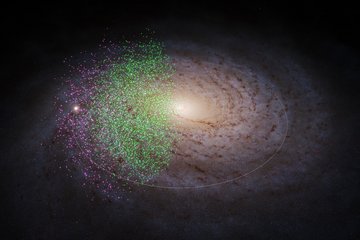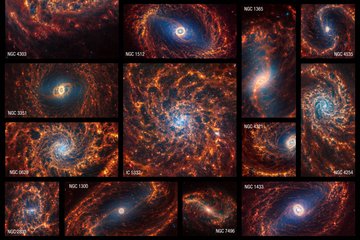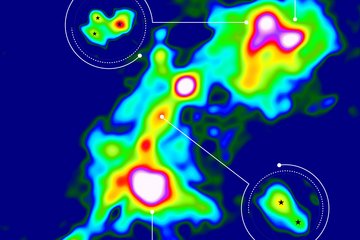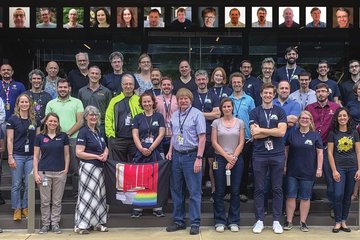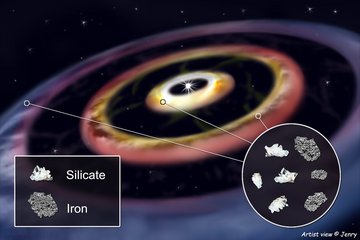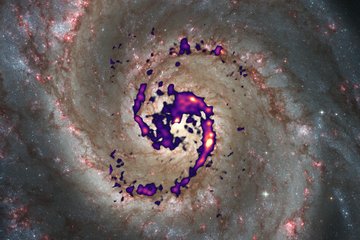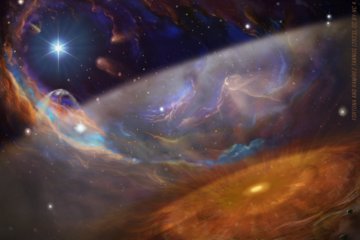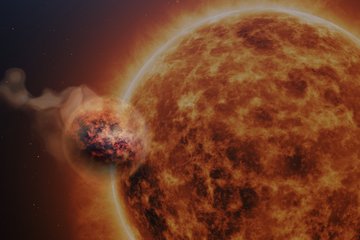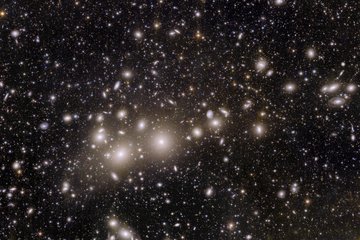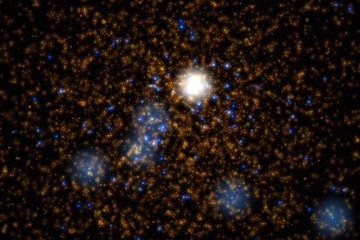JWST peers into the heart of a starburst galaxy
Astronomers identify the origins of a galactic wind caused by intense star formation and fireworks of supernova explosions.
A team of astronomers, including MPIA’s Leindert Boogaard and Fabian Walter, used the James Webb Space Telescope’s (JWST) supreme infrared sensitivity to investigate the environment of exceptionally intense star formation in the centre of the starburst galaxy Messier 82 (M82). They used large organic molecules to map the massive galactic wind expelling vast amounts of gas caused by star formation and supernova explosions in unprecedented detail and trace its origin back to the dense stellar clusters in the galaxy’s disk. The study is a big step towards a better understanding of how M82 is forming stars and how this extreme activity is affecting the galaxy as a whole.

Starbursts are phases of rapid and efficient star formation. Most galaxies have experienced periods of intense star formation in the universe’s early history more than 10 billion years ago. However, investigating these conditions is difficult because of their sheer distance. Luckily, some starburst galaxies are relatively close, permitting a detailed look into those extreme environments.
A galactic laboratory
One of those galaxies is Messier 82 (M82). Located 12 million light-years away in the constellation Ursa Major, it is relatively compact in size. Still, it hosts a frenzy of star formation activity. For comparison, M82 is sprouting new stars ten times faster than the Milky Way galaxy. About 10 million years ago, that ratio was even as high as 80.
“M82 is the prototypical starburst galaxy with a beautiful multi-phase outflow and thus a great laboratory to study these kinds of extreme environments,” said Leindert Boogaard, a post-doctoral researcher at the Max Planck Institute for Astronomy (MPIA) in Heidelberg, Germany, and co-author of the underlying study published in The Astrophysical Journal today. “They play an important role in galaxy formation and evolution but are very difficult to study at cosmological distances.”
“Our research group has been studying the galactic wind in M82 for many years,” said Fabian Walter, a research group leader at MPIA. He is another co-author of the research article. Exploiting the superb resolving power of JWST’s NIRCam (Near-Infrared Camera) instrument at infrared wavelengths, the team led by Alberto Bolatto (University of Maryland, USA) managed to obtain an unprecedented detailed look at the physical conditions that foster the formation of new stars.
“Until now, we detected both cold and hot, ionized gas in the large outflows. The latest JWST observations provide a new view into the seemingly contradicting conditions at unprecedented resolution and sensitivity,” Walter adds.
A Vibrant Community of Stars

Star formation continues to maintain a sense of mystery because it is shrouded by curtains of dust and gas, creating an obstacle in observing this process. Fortunately, JWST’s ability to peer into the infrared is an asset in navigating these murky conditions. Additionally, these NIRCam images of the very centre of the starburst were obtained using an instrument mode that prevented the very bright source from overwhelming the detector.
While dark brown tendrils of heavy dust pervade M82’s glowing white core even in this infrared view, JWST’s NIRCam revealed a level of detail that has historically been obscured. Looking closer towards the centre, small red patches signify regions where molecular hydrogen lights up under the influence of a nearby young star’s radiation. Specks depicted in green denote concentrated areas of iron, most of which are supernova remnants.
Supernova explosions happen at the end of a massive star’s short lifetime. Hence, following an epoch with a high star formation rate, starbursts also give rise to an intense era of supernovae. As a result, the explosions strongly contribute to a galactic wind, which drives gas and dust into the galaxy’s halo. Observations restricted to specific wavelengths unveil the material rising far above and below the galactic disk.
Finding Structure in Lively Conditions

One area of focus for this research team was understanding how this galactic wind, which is caused by the rapid rate of star formation and subsequent supernovae, is being launched and influencing its surrounding environment. By resolving a central section of M82, scientists examined where the wind originates and gained insight into how hot and cold components interact.
The NIRCam instrument is well-suited to trace the structure of the galactic wind via emission from molecules known as polycyclic aromatic hydrocarbons (PAHs). PAHs are considered tiny grains at the border between large molecules and sooty dust particles that survive in cooler temperatures but disintegrate in hot conditions.
Much to the team’s surprise, the new view of the PAH emission highlights the galactic wind’s fine structure – an aspect previously unknown. Depicted as red filaments, the emission extends away from the central region where the heart of star formation resides. Another unanticipated find was the similar structure between the PAH emission and that of hot, ionized gas.
“It was unexpected to see the PAH emission resemble ionized gas,” said Bolatto, lead author of the study. “PAHs are not supposed to live very long when exposed to such a strong radiation field, so perhaps they are continuously being replenished. It challenges our theories and shows us that further investigation is required.”
“It’s exciting to see the spectacular detail in the outflow lighting up in PAH emission, which demonstrates the power of JWST,” Boogaard points out. “The new observations provide us vital information on how these outflows are launched and how they impact their surrounding environment.”
Lighting a Path Forward
The observations of M82 in near-infrared light spur further questions about star formation, some of which the team hopes to answer with additional data gathered with the JWST.
In the near future, the team will have spectroscopic observations of M82 from JWST ready for their analysis, as well as complementary large-scale images of the galaxy and wind. Spectral data will help astronomers determine accurate ages for the star clusters and provide a sense of timing for how long each phase of star formation lasts in a starburst galaxy environment. On a broader scale, inspecting the activity in galaxies like M82 can deepen astronomers’ understanding of the early universe.
After all, JWST is capable of studying galaxies at all distances. In addition to looking at young, far-away galaxies, astronomers can look at targets closer to home to gather a detailed insight into the processes happening here – events that also occurred in the early universe.
Additional information
The MPIA scientists involved in this study are Leindert A. Boogaard and Fabian Walter.
Other researchers include Alberto D. Bolatto (Department of Astronomy and Joint Space-Science Institute, University of Maryland, College Park, USA), Rebecca C. Levy (Steward Observatory, University of Arizona, Tucson, USA), and Elizabeth Tarantino (Space Telescope Science Institute, Baltimore, USA).
The Near Infrared Camera (NIRCam) is JWST’s primary imager covering the infrared wavelength range of 0.6 to 5 microns, providing high-resolution imaging and spectroscopy for various investigations. It is equipped with coronagraphs, instruments that allow astronomers to take pictures of very faint objects around a central bright object, like stellar systems. NIRCam was built by a team at the University of Arizona and Lockheed Martin’s Advanced Technology Center.
JWST is the world’s premier space science observatory. It is an international program led by NASA with its partners, ESA (European Space Agency) and CSA (Canadian Space Agency).
This press release is based on the Space Telescope Science Institute’s version.
MN




